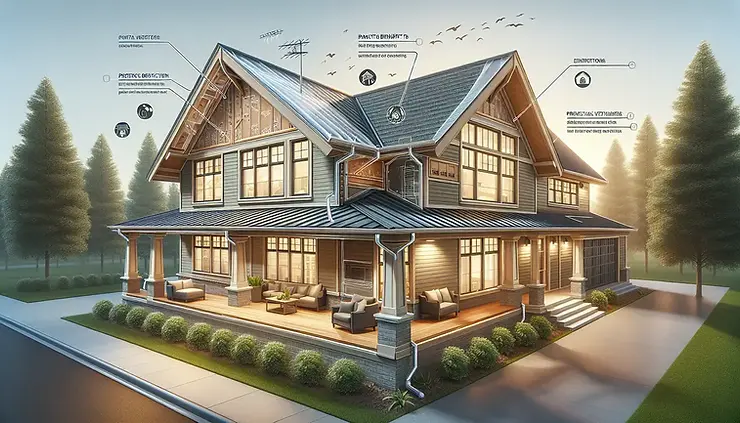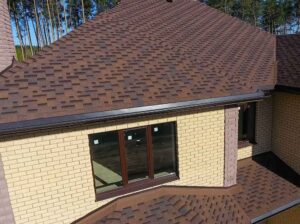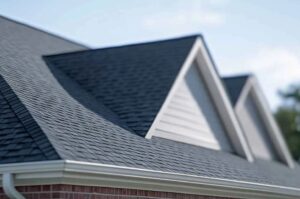Introduction to Soffit and Its Importance
Soffit might not be a term you hear every day, but it plays a critical role in keeping your home in top shape. It’s the material between the roof’s edge and the side of your building. Think of it as the bridge connecting your roof and walls. Its main job? To ventilate your attic and protect your rafters from the elements, especially moisture. Without proper soffit, your attic could become a sauna in summer, a freezer in winter, and a breeding ground for mold year-round. Plus, soffit helps keep critters out. It’s a small component with big responsibilities. Ensuring your home has the right soffit installation means protecting your home from damage while keeping your ventilation game strong.

The Role of Soffit Installation in Home Ventilation
Soffit plays a key role in keeping your home cool and dry. It’s basically the bridge between your roof’s edge and the side of your house. By installing soffit, you’re letting your roof breathe. This means during hot days, the soffit vents draw cool air from outside into the attic. This air movement pushes out the hot air through the ridge vent, cooling your house. In winter, this ventilation prevents moisture buildup in the attic, which can lead to mold and rot. So, simply put, soffit helps in managing temperature and moisture in your home, keeping your living space comfortable and protecting your roof structure from premature decay.
How Soffit Protects Your Home from Weather and Pests
Without soffit, your home is like a soldier without armor in the battle against weather and pests. Think about soffit as your home’s shield. It sits tucked away under the overhangs of your roof, but don’t let its low-key position fool you—it plays a huge role. Firstly, when rainstorms hit, soffit keeps water from sneaking into your attic. Imagine water getting in, soaking your insulation, and making a comfy home for mold. Not what you want, right? Soffit blocks water’s entry path, keeping your attic dry and your home safe.
But there’s more. Ever worried about critters setting up camp in your attic? Soffit helps there too. It’s like a barrier that says, “No vacancy” to birds, squirrels, and all their friends who think your attic is the perfect hangout spot. By sealing off this potential entrance, soffit keeps these uninvited guests at bay.
So, summing it up, soffit protects your home from water damage and pests—two big threats. It’s not just a cosmetic detail; it’s a fundamental part of your home’s defense system. Keep that shield strong.
Types of Soffit Materials and Their Advantages
Soffit materials come in a variety of types, each with its own set of benefits for your home. First up, vinyl soffits are a popular pick. They are known for being water-resistant and easy on the wallet. Perfect for areas that see a lot of moisture, vinyl won’t rot or get easily damaged by water. Next, we’ve got aluminum soffits. These guys are tough. They can stand up to most weather conditions and don’t rust, making them a solid choice for homes in both hot and cold climates. Plus, they’re fire-resistant. Then, there’s wood soffits. If you’re going for that classic look, wood is the way to go. It offers a natural beauty that’s hard to beat but remember, it requires more upkeep to protect against moisture and pests. Lastly, fiber cement soffits are gaining traction. They blend durability with a lower need for maintenance. Resistant to fire, rot, and pests, they’re a strong contender if you’re looking for a long-term solution. Each material has its merits, so consider your home’s specific needs and your budget when choosing.
Signs Your Home Needs a Soffit Installation or Upgrade
If you’re not sure whether your home needs a soffit installation or an upgrade, keep an eye out for these signs. First up, peeling paint or sagging material on your home’s exterior can indicate moisture damage, a clear signal that your soffits might be failing to protect against the elements. Secondly, if your attic seems hotter than Hades or you spot ice dams forming along the roof in winter, this could mean your soffits aren’t ventilating properly. A well-ventilated attic helps regulate your home’s temperature, keeping it cooler in summer and preventing ice dams in winter. Another telltale sign is a critter invasion. If you’ve got birds, squirrels, or insects treating your attic like their personal playground, it’s likely because your soffits are damaged or non-existent, offering an open invitation. Seeing mold or water stains on your soffit panels is also a red flag. It means moisture is getting trapped and your home’s protection against water damage might be compromised. Lastly, if your energy bills have been climbing without a clear reason, poor attic ventilation could be the culprit, making your HVAC system work overtime. So, if these signs are hitting a little too close to home, it might be time to consider a soffit installation or an upgrade to keep your home cool, dry, and critter-free.
The Process of Soffit Installation: A Step-by-Step Guide
First, understand that installing soffits is not just about slapping some material under your roof; it’s about protecting your home. The process begins with a thorough inspection of your existing structures. If there’s damage or decay, that needs fixing first. Step one is to measure carefully. You need to know exactly how much soffit you’ll need. Get this wrong, and you’re either wasting materials or making another trip to the store. Next up, choose your soffit material. Options vary from vinyl, aluminum, to wood. Each has its perks. Vinyl’s low maintenance, aluminum’s durable, and wood looks great but needs more care. Once materials are sorted, we’re on to installing the soffit panels. Start from the home’s wall and work your way outwards, making sure each panel is securely fastened and aligned properly. Ventilation is key, so if your soffits are vented, ensure those parts go where they’ll do their job best. Lastly, it’s about adding fascia to cover the edges, giving everything a polished look. In a nutshell, soffit installation is measure, choose, install, ventilate, and beautify. Do it right, and you’re not just adding to your home’s curb appeal; you’re protecting it from weather and pests and improving its ventilation. Remember, precision is everything.
Ventilation Benefits: Keeping Your Attic Cool and Dry
Good airflow in your attic isn’t just about keeping it from turning into an oven in the summer. It’s crucial for preventing moisture build-up that can lead to mold, mildew, and wood rot. That’s where soffit installation comes into play. Soffits are the underbelly of your roof’s overhang, and they’re designed with vents to pull fresh air in. This movement of air pushes the hot, moist air out through your roof’s ridge vent, creating a constant airflow. This doesn’t just protect your attic; it helps keep your whole house cooler, cutting down on those brutal AC bills during the hot months. Without proper ventilation, your attic can become a moisture magnet. That’s bad news for your home’s structure and can lead to expensive repairs down the line. So, installing soffits with vents is a smart move to protect your home and save money. Plus, it’s a key step in keeping your attic space dry and cool, regardless of how scorching the sun gets.
Soffit and Energy Efficiency: Lowering Heating and Cooling Costs
Soffit plays a key role in making your home more energy-efficient. How? By helping control the temperature inside, reducing the need for your heating and cooling system to work overtime. Here’s the deal. In summer, soffits let air flow into your attic, keeping it cooler. This means your air conditioner won’t have to fight as hard to keep your home comfortable. In winter, those same soffits prevent excessive moisture from building up in your attic, reducing the risk of insulation damage. Damaged insulation can lead to heat escaping your home, forcing your heating system to work harder and bumping up your bills. So, installing soffits or keeping them in good shape can lead to noticeable savings on your energy costs. It’s a simple step that not only protects your home but also keeps your wallet a bit fuller by cutting down those heating and cooling expenses.
Maintenance Tips for Your Home’s Soffit
Keep your soffit clean and free from debris. This means regularly checking and clearing out leaves, twigs, and anything else that might clog it. Clogged soffits don’t ventilate well, which defeats their purpose. If you spot any signs of insect or animal nests, remove them immediately. These can cause damage and block airflow. Inspect your soffit for signs of wear and tear. Look for cracks, holes, or any damage that could let in water or pests. These issues need fixing right away to prevent more extensive problems. Paint your soffit if it’s made of wood. This not only keeps it looking good but also adds an extra layer of protection against the elements. Choose a paint that’s suitable for exterior use and specifically designed to withstand weather conditions. Make sure your soffit’s ventilation is not obstructed. The vents should always be clear to ensure proper airflow in your attic. Blocked vents can lead to moisture buildup, which invites mold growth and can deteriorate your home’s structure. If you’re not comfortable doing these maintenance tasks yourself, consider hiring a professional. They can spot potential problems more easily and ensure your soffit performs its job well, protecting your home.
Conclusion: Enhancing Your Home’s Longevity and Value Through Soffit Installation
Wrapping this up, don’t overlook the importance of soffit installation. Not just an aesthetic addon, soffits serve a vital role in protecting your home from moisture and pests while ensuring proper ventilation in your attic. By investing in soffit installation, you’re not just preventing expensive repairs down the line; you’re also boosting your home’s overall value. Remember, a well-ventilated home is a healthier home. So, consider the long-term benefits of adding soffits – your home’s longevity and value depend on it.




